Autism Spectrum Disorder (ASD)

Hello and welcome to this presentation focused on autism spectrum disorder (ASD). The presentation covers various aspects of ASD, such as DSM criteria and number, the onset of ASD, including age and population, possible co-morbidities, traditional and non-traditional treatments, and a case study of the condition.
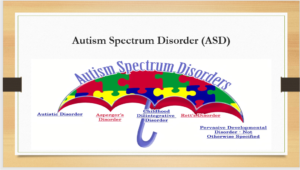
Autism Spectrum Disorder (ASD) is a group of neurodevelopmental diseases affecting how patients perceive their environment, people, relationships, and socializing (Sauer et al., 2021). As a spectrum, ASD means it presents multiple developmental disorders with a wide of symptoms that vary in severity. ASD today encompasses various disorders that were previously identified individually, including autism, Asperger’s syndrome, childhood disintegrative disorder, and an unspecified form of pervasive developmental disorder (Hodges et al., 2020). ASD leads to communication problems and related social and socialization issues. Individuals with ASD may also show repetitive behavioral patterns (Hodges et al., 2020). The prevalence of ASD in the United States is high, estimated to be 1 in every 36 children and 1 in 100 people.
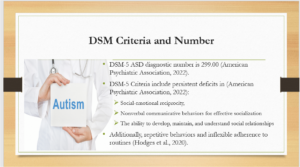
The Diagnostic and Statistical Manual of Mental Disorders (DSM) 5th edition is an improved classification system developed by the American Psychiatric Association (APA) (2022) used to diagnose mental health disorders. The DSM-5 provides specific criteria and diagnostic codes for diagnosing ASD. The number for ASD in the DSM-5 is 299.00 (American Psychiatric Association, 2022). The specific diagnostic criteria for ASD include a focus on social communication and interaction and four types of restricted and repetitive behaviors. The DSM-5 requires that the child display persistent deficits in their ability to reciprocate social-emotional interactions, such as interests and sharing, nonverbal communicative behaviors that are necessary for effective socialization, such as body language and gestures, and persistent deficits in the ability of the child to develop, maintain, and understand social relationships (American Psychiatric Association, 2022). Additionally, other notable criteria for diagnosing ASD include repetitive behaviors inflexible adherence to routines, and fixed interests (Hodges et al., 2020).
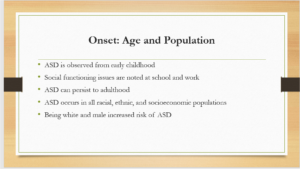
ASD symptoms and signs can occur from early childhood through adulthood. However, children are more likely with ASD than adults (van ‘t Hof et al., 2021). However, a more conclusive diagnosis can be made from the age of two years and above. The social functioning issues related to ASD are more notable as the child develops and is socially active, mostly in school and work settings. ASD can be diagnosed in all populations regardless of race, ethnicity, and socioeconomic status. However, ASD is more common in male children and adults than in women and girls (Hodges et al., 2020). additionally, being white and male also increases the risk of ASD (Hodges et al., 2020). Adults with ASD are more likely to have high executive function regardless of their poor social functioning (Johnston et al., 2019).

People who have ASD experience other mental and physical complications that affect their functioning and the severity of ASD. ASD are most likely to have existing comorbid conditions such as intellectual and learning disabilities that have been observed in an estimated 50 percent of all ASD cases, and attention deficit hyperactivity disorder (ADHD) is evidenced in over 60 percent of patients diagnosed with ASD (Hodges et al., 2020). Other notable comorbid conditions that the DSM-5 identifies include anxiety disorders and epilepsy or seizure disorders that need to be defined during diagnosis (American Psychiatric Association, 2022). Additionally, children diagnosed with ASD are also likely to have comorbid gastrointestinal issues (Hodges et al., 2020).
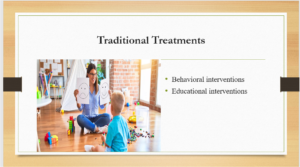
Although there is no actual cure for ASD, there are various traditional and modern treatment methods that have been developed to help manage ASD. The traditional treatments are behavioral treatment methods such as Applied Behavior Analysis (ABA) and Pivotal Response Treatment (PRT). Another traditional method of treating and managing ASD is through educational treatment methods such as individualizing education programs applicable at home and school. These traditional treatment methods focus on improving communication and other social skills.

Advances made in research have helped understand the etiology and pathology of ASD, which have supported the development of alternative treatment methods. Besides education and behavioral therapies, ASD can be managed through medications such as melatonin to induce sleep, music, and art therapy (Zhukova et al., 2020). The use of diet as an intervention, such as gluten-free, casein-free (GFCF) diets as well as neurofeedback therapy as alternative and complementary therapies (van Hoogdalem et al., 2021), have also been found to be effective in improving ASD symptoms.

J.P., a 4-year-old Caucasian boy, was brought to the clinic by his mother with complaints that he has some behaviors they do not understand. The mother ignored the behaviors in the early days, noting that she thought J.K. was a late bloomer. She notes that J.K. barely responds to his name when called and usually wakes up and sits in the same spot daily. J.K. also never interacts with other kids and usually seems moody. During the visit, his voice was monotonous, making it hard to hold onto a conversation.
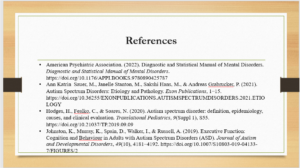
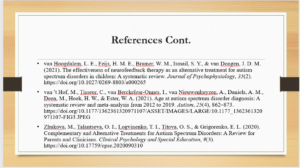
ORDER A PLAGIARISM-FREE PAPER HERE
We’ll write everything from scratch
Question 
Disorder Research Paper OR PowerPoint Presentation
Pick a Disorder and Research the Disorder
• Disorder Name
• DSM criteria and number
• Onset (age or population)
• Co-morbidities
• Traditional treatments
• Non-traditional treatment
• Case Study
PowerPoint:
• This will be presented using a PowerPoint, approximately 8-10 minutes long, and include the above
criteria

Autism Spectrum Disorder (ASD)
• 5X5 Rule (no more than 5 lines per slide; 5 words per line)
• Use pictures and/or a visual icon where appropriate
• “YOU” is the presentation, not the PowerPoint
• This will involve using NARRATION and a video of you in the corner
• Do NOT read your information; instead present it casually, as if you were telling a group of friends
• Include all above components and cite your sources both visually and verbally (do NOT need to cite
images)
• This PP Presentation should be approximately 7 slides NOT including the Intro or Works cited
• Include a reference list slide (APA formatting)
Research Paper:
• This paper will include a cover page, reference page, and APA citing within your sources using APA
• Each section of the paper can have a subtitle (APA formatted) that corresponds with the above
• The paper should be approximately 5 pages NOT including the cover and reference page
• No abstract is necessary
• Stay away from first-person language like “I,” “we,” “us,” etc.…
• Include a reference page (APA formatting)—those references connect to the in-text citations that
are indicated throughout the actual paper

